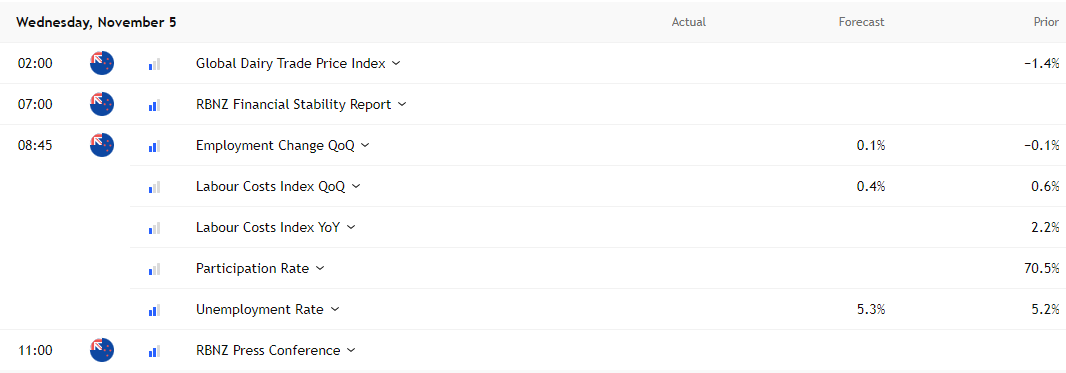ReElement Technologies stock soars after securing $1.4B government deal
The Kiwi’s October rally has been wiped out as Powell’s hawkish tone sparks a sharp reversal. With key labour market data looming, downside risks are mounting fast.
- Powell’s hawkish tone flipped NZD/USD bearish
- Weekly shooting star warns of downside risk
- Rising wedge break on dailies opens path to October lows
- Jobs data could drive next RBNZ move
Summary
The price action in NZD/USD turned decidedly bearish last week, coinciding with a renewed bout of U.S. dollar strength sparked by a recalibration of the U.S. interest rate outlook as Jerome Powell cast doubt on whether the FOMC will deliver a third consecutive rate cut in December.
Traders had deemed such an outcome a near lock, resulting in a wave of pressure on US dollar-denominated assets, including markets important to the Kiwi such as dairy prices. If the signals on the charts prove reliable, downside risks for NZD/USD are building as we near the release of crucial employment data in New Zealand.
Kiwi Slides on Powell Pivot
Like so many other riskier asset classes, the hawkish tilt from Jerome Powell following the October FOMC meeting weighed heavily on the Kiwi dollar, resulting in a sharp reversal that changed the picture entirely for NZD/USD across multiple timeframes. That can be seen in the left-hand pane of the chart below, with a shooting star printing on the weeklies, warning of renewed downside even if it didn’t arrive after an extended uptrend.
Source: TradingView
The bearish signal followed a sharp lift in the rolling five-day correlation between NZD/USD and multiple tenors across the U.S. interest rate curve, as demonstrated in the right-hand pane. From top to bottom, we have implied market pricing for Fed rate cuts out to the end of next year, with 2-year and 10-year Treasury yields following next.
At 0.89, -0.92 and -0.93, respectively, it’s clear that as U.S. yields rose, NZD/USD typically declined. Given the strength of the relationship NZD/USD saw with the offshore-traded Chinese yuan and whole milk powder futures traded on the SGX, which are the fourth and fifth correlation coefficients shown, the Kiwi wasn’t the only cyclical asset undermined by the Fed’s less-dovish shift, creating an environment conducive to weakness.
Rising Wedge Break Warns of Downside Risk

Source: TradingView
Like the message from the NZD/USD weekly chart, the signals from the daily only add to the bearish picture, with a key reversal candle printing on Wednesday after failing at .5800 resistance, contributing to follow-through selling that saw the pair deliver a bearish break of the rising wedge it had been trading in. Having sliced through uptrend support, convention suggests a potential retest of the October low around .5683 may be on the cards, with .5678 and .5640 other known support levels after that.
Mirroring the price action, the momentum picture has shifted far more bearish, with RSI (14) through its uptrend and now sinking further away from neutral territory, pointing to strengthening downside pressure. MACD looks like it may soon confirm, curling over towards the signal line from above while remaining firmly in negative territory. The pair just looks heavy and vulnerable to downside.
The one small area of caution is the price action seen in mid-October, with multiple bearish probes beneath .5715 resulting in reversals. The macro backdrop is not the same, but it should be a consideration for anyone looking at shorts around these levels. The preference would be to sell into rallies towards minor resistance at .5755, should the price return there. That would create a more appealing setup where stops could be placed above to protect against reversal. If the pair were to reverse back above .5755 and close there, the bearish bias would be nixed, putting potential long setups in play seeking a return initially to .5800 resistance.
Kiwi Unemployment Data Looms Large
While the U.S. calendar has some decent risk events this week, as covered in a separate note looking at USD/JPY, the domestic calendar in New Zealand may contain the biggest source of volatility with the release of crucial labour market data for the September quarter. While the Reserve Bank of New Zealand (RBNZ) has a sole inflation mandate, more recently its decision-making process has been heavily influenced the labour market. Unemployment has continued to trend higher even with participation rates falling, keeping the domestic inflation outlook subdued.
Source: TradingView (AEDT)
Should the data released on Wednesday fail to show any meaningful recovery in the labour market, it will increase the probability of the RBNZ adding to the 300 basis points of rate cuts already delivered this cycle.
While a 25-basis-point cut at the bank’s final meeting of the year on November 26 is nearly fully priced, with the RBNZ not afraid to deliver large cuts as seen by the 50-point reduction in October, continued signs of weakness may see traders begin to price the cash rate falling beneath 2% this cycle. Only an across-the-board beat in key labour market measures would likely be enough to see markets begin to reduce the probability of further easing this cycle.
Based on the RBNZ’s latest forecasts, it sees unemployment peaking at 5.3% in Q3 with no employment growth and a participation rate of 70.4%.
Private sector wages—which typically are influential on domestic inflation pressures—are seen lifting 0.4% for the quarter and 2.1% for the year, the latter in line with the midpoint of the RBNZ’s 1–3% inflation target band. Unless estimated economic slack is not as significant as thought, the latter points to a subdued outlook for overall inflationary pressures.
